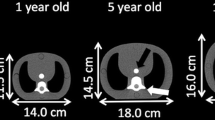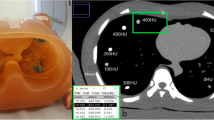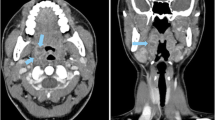Abstract
Purpose
To evaluate noise level and contrast-to-noise ratio (CNR) with various kVp-mAs pairs producing the same computed tomography dose index (CTDI) value. The 80 kVp and new 70-kVp settings were compared.
Materials and methods
The noise was measured in 10 ovoid water phantoms with different diameters from 10 cm to 28 cm. Contrast was obtained from CTs of iodine-filled tubes. Spiral acquisition protocols at 70 kVp and 80 kVp, with the same CTDI, were applied. In the clinical study, two matched groups, each of 21 paediatric patients, underwent 70-kVp or 80-kVp ECG-gated iodinated-enhanced sequential CT.
Results
Noise was significantly higher with 70 kVp than 80-kVp settings for all phantom sizes. Estimated CNR with phantoms was higher at 70 kVp than 80 kVp, and the difference decreased from 17 % to 3 % as phantom size increased. The mean CNR in paediatric patients was 15.2 at 70 kVp and 14.3 at 80 kVp (ns). The CNR difference was significantly larger in the small-child subgroup.
Conclusion
Noise level is slightly higher at the 70-kVp than the 80-kVp setting, but the CNR is higher, particularly for small children. Therefore, 70 kVp may be appropriate for contrast-enhanced CT examinations and 80 kVp for non-enhanced CT in small children.
Key Points
• 70-kVp settings provide a slightly higher noise level compared to 80-kVp settings.
• The CNR is higher with 70-kVp than with 80-kVp settings.
• Without contrast, 80-kVp settings may be preferable over 70-kVp settings.


Similar content being viewed by others
Abbreviations
- ALARA:
-
As Low as Reasonably Achievable
- CNR:
-
Contrast-to-Noise Ratio
- CT:
-
Computed Tomography
- CTDI:
-
Computed Tomography Dose Index
- HU:
-
Hounsfield Unit
- kVp:
-
Peak Kilovoltage
- ROI:
-
Region of Interest
References
Brenner DJ, Hall EJ (2007) Computed tomography—an increasing source of radiation exposure. N Engl J Med 357:2277–2284
Chodick G, Kim KP, Shwarz M, Horev G, Shalev V, Ron E (2009) Radiation risks from pediatric computed tomography scanning. Pediatr Endocrinol Rev 7:29–36
Pearce MS, Salotti JA, Little MP et al (2012) Radiation exposure from CT scans in childhood and subsequent risk of leukaemia and brain tumours: a retrospective cohort study. Lancet 380:499–505
Slovis TL (2002) The ALARA concept in pediatric CT: myth or reality? Radiology 223:5–6
Kalender WA, Buchenau S, Deak P et al (2008) Technical approaches to the optimisation of CT. Phys Med 24:71–79
Herzog C, Mulvihill DM, Nguyen SA et al (2008) Pediatric cardiovascular CT angiography: radiation dose reduction using automatic anatomic tube current modulation. AJR Am J Roentgenol 190:1232–1240
van der Wall EE, van Velzen JE, de Graaf FR, Jukema JW (2012) Reduction of radiation dose using 80 kV tube voltage: a feasible strategy? Int J Cardiovasc Imaging 28:425–428
Wang D, Hu XH, Zhang SZ et al (2012) Image quality and dose performance of 80 kV low dose scan protocol in high-pitch spiral coronary CT angiography: feasibility study. Int J Cardiovasc Imaging 28:415–423
Kalender WA, Deak P, Kellermeier M, van Straten M, Vollmar SV (2009) Application- and patient size-dependent optimization of x-ray spectra for CT. Med Phys 36:993–1007
Goo HW, Park IS, Ko JK, Kim YH, Seo DM, Park JJ (2005) Computed tomography for the diagnosis of congenital heart disease in pediatric and adult patients. Int J Cardiovasc Imaging 21:347–365, discussion 67
Lee T, Tsai IC, Fu YC et al (2006) Using multidetector-row CT in neonates with complex congenital heart disease to replace diagnostic cardiac catheterization for anatomical investigation: initial experiences in technical and clinical feasibility. Pediatr Radiol 36:1273–1282
Paul JF, Abada HT (2007) Strategies for reduction of radiation dose in cardiac multislice CT. Eur Radiol 17:2028–2037
Paul JF, Abada HT, Sigal-Cinqualbre A (2004) Should low-kilovoltage chest CT protocols be the rule for pediatric patients? AJR Am J Roentgenol 183:1172, author reply
Karabulut N, Ariyurek M (2006) Low dose CT: practices and strategies of radiologists in university hospitals. Diagn Interv Radiol 12:3–8
Siegel MJ, Schmidt B, Bradley D, Suess C, Hildebolt C (2004) Radiation dose and image quality in pediatric CT: effect of technical factors and phantom size and shape. Radiology 233:515–522
Dong F, Davros W, Pozzuto J, Reid J (2012) Optimization of kilovoltage and tube current-exposure time product based on abdominal circumference: an oval phantom study for pediatric abdominal CT. AJR Am J Roentgenol 199:670–676
Brady SL, Kaufman RA (2012) Investigation of American Association of Physicists in Medicine Report 204 size-specific dose estimates for pediatric CT implementation. Radiology 265:832–840
Zatelli G, Ciccarone A, Mazzocchi S, Fonda C (2008) A study of feasibility of dose reduction in paediatric MSCT scanning with a constant image quality. Phys Med 24:107–111
Reid J, Gamberoni J, Dong F, Davros W (2010) Optimization of kVp and mAs for pediatric low-dose simulated abdominal CT: is it best to base parameter selection on object circumference? AJR Am J Roentgenol 195:1015–1020
Ben Saad M, Rohnean A, Sigal-Cinqualbre A, Adler G, Paul JF (2009) Evaluation of image quality and radiation dose of thoracic and coronary dual-source CT in 110 infants with congenital heart disease. Pediatr Radiol 39:668–676
Kim JE, Newman B (2010) Evaluation of a radiation dose reduction strategy for pediatric chest CT. AJR Am J Roentgenol 194:1188–1193
Sigal-Cinqualbre AB, Hennequin R, Abada HT, Chen X, Paul JF (2004) Low-kilovoltage multi-detector row chest CT in adults: feasibility and effect on image quality and iodine dose. Radiology 231:169–174
Yu L, Bruesewitz MR, Thomas KB, Fletcher JG, Kofler JM, McCollough CH (2011) Optimal tube potential for radiation dose reduction in pediatric CT: principles, clinical implementations, and pitfalls. Radiographics 31:835–848
Acknowledgments
The scientific guarantor of this publication is Jean-François Paul, MD. The authors of this manuscript declare no relationships with any companies whose products or services may be related to the subject matter of the article. The authors state that this work has not received any funding. No complex statistical methods were necessary for this paper. Institutional Review Board approval was obtained. Written informed consent was obtained from all subjects (parents of children) in this study. Methodology: prospective case-control experimental study, performed at one institution.
Author information
Authors and Affiliations
Corresponding author
Rights and permissions
About this article
Cite this article
Durand, S., Paul, JF. Comparison of image quality between 70 kVp and 80 kVp: application to paediatric cardiac CT. Eur Radiol 24, 3003–3009 (2014). https://doi.org/10.1007/s00330-014-3341-4
Received:
Revised:
Accepted:
Published:
Issue Date:
DOI: https://doi.org/10.1007/s00330-014-3341-4




